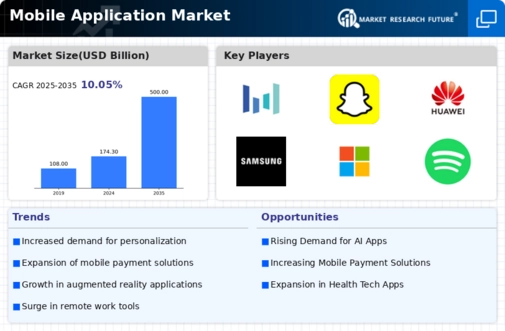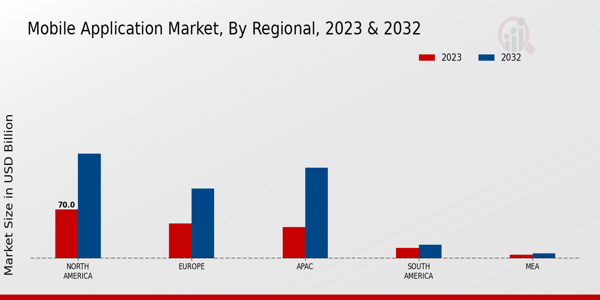Expansion of 5G Technology
The rollout of 5G technology is poised to revolutionize the Global Mobile Application Market Industry by enhancing connectivity and enabling faster data transfer. With 5G networks expected to cover a significant portion of the globe by 2024, mobile applications can leverage this technology to provide seamless user experiences. Enhanced speeds and reduced latency will facilitate the development of more sophisticated applications, including augmented reality and virtual reality experiences. This technological advancement is likely to attract more users, thereby increasing the overall market size. The integration of 5G technology may also contribute to the projected CAGR of 10.05% for the period from 2025 to 2035.
Rising Smartphone Penetration
The increasing penetration of smartphones globally serves as a primary driver for the Global Mobile Application Market Industry. As of 2024, the number of smartphone users is projected to reach approximately 6.8 billion, which represents a significant portion of the global population. This surge in smartphone adoption facilitates greater access to mobile applications across various demographics. Consequently, developers are incentivized to create innovative applications tailored to diverse user needs, thereby expanding the market. The anticipated growth in smartphone usage is likely to contribute to the market's valuation of 174.3 USD Billion in 2024, indicating a robust demand for mobile applications.
Growing Demand for Mobile Gaming
The mobile gaming sector is experiencing exponential growth, which significantly influences the Global Mobile Application Market Industry. With the global gaming market projected to reach 500 USD Billion by 2035, mobile gaming is becoming a dominant segment. This trend is fueled by advancements in mobile technology, enabling high-quality graphics and immersive experiences. Moreover, the increasing popularity of esports and competitive gaming is attracting a broader audience. As a result, developers are focusing on creating engaging gaming applications, which not only enhances user engagement but also drives revenue through in-app purchases and advertisements. This dynamic landscape suggests a promising future for mobile gaming applications.
Emergence of E-commerce Applications
The rapid growth of e-commerce is significantly impacting the Global Mobile Application Market Industry. With consumers increasingly preferring online shopping, mobile applications that facilitate e-commerce transactions are becoming essential. The convenience of shopping via mobile devices, combined with personalized user experiences, is driving the adoption of these applications. As of 2024, the e-commerce sector is expected to continue its upward trajectory, contributing to the overall market growth. This trend indicates a shift in consumer behavior, where mobile applications serve as vital tools for businesses to engage with customers effectively. The integration of advanced payment solutions within these applications further enhances their appeal.
Increased Focus on Health and Wellness Apps
The rising awareness of health and wellness is driving the demand for mobile applications in the Global Mobile Application Market Industry. As individuals increasingly prioritize their health, applications that offer fitness tracking, mental health support, and telemedicine services are gaining traction. The proliferation of wearable devices further complements this trend, allowing users to monitor their health metrics conveniently. This growing focus on health and wellness applications not only caters to consumer needs but also presents lucrative opportunities for developers. The market's expansion in this segment is indicative of a broader shift towards preventive healthcare, which is likely to sustain growth in the coming years.

























Leave a Comment